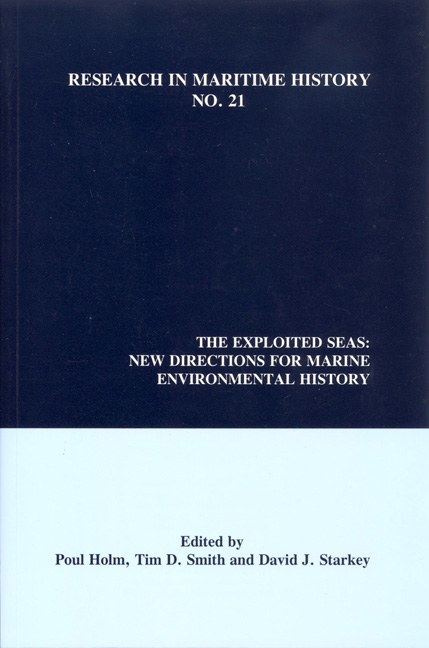Book contents
- Frontmatter
- Contents
- About the Editors
- Contributors
- “Introduction”
- Contributions
- “The Newfoundland Fisheries, c. 1500-1900: A British Perspective”
- “Testing Ecological Models: The Influence of Catch Rates on Settlement of Fishermen in Newfoundland, 1710-1833”
- “Nineteenth-Century Expansion of the Newfoundland Fishery for Atlantic Cod: An Exploration of Underlying Causes”
- “Status and Potential of Historical and Ecological Studies on Russian Fisheries in the White and Barents Seas: The Case of the Atlantic Salmon (Salmo Salar)”
- “The Danish Fisheries, c. 1450-1800: Medieval and Early Modern Sources and Their Potential for Marine Environmental History”
- “Historical Approaches to the Northern California Current Ecosystem”
- “Potential for Historical-Ecological Studies of Latin American Fisheries”
- “The South African Fisheries: A Preliminary Survey of Historical Sources”
- “The Potential for Historical Studies of Fisheries in Australia and New Zealand”
- “Examining Cetacean Ecology Using Historical Fishery Data”
“Testing Ecological Models: The Influence of Catch Rates on Settlement of Fishermen in Newfoundland, 1710-1833”
from Contributions
- Frontmatter
- Contents
- About the Editors
- Contributors
- “Introduction”
- Contributions
- “The Newfoundland Fisheries, c. 1500-1900: A British Perspective”
- “Testing Ecological Models: The Influence of Catch Rates on Settlement of Fishermen in Newfoundland, 1710-1833”
- “Nineteenth-Century Expansion of the Newfoundland Fishery for Atlantic Cod: An Exploration of Underlying Causes”
- “Status and Potential of Historical and Ecological Studies on Russian Fisheries in the White and Barents Seas: The Case of the Atlantic Salmon (Salmo Salar)”
- “The Danish Fisheries, c. 1450-1800: Medieval and Early Modern Sources and Their Potential for Marine Environmental History”
- “Historical Approaches to the Northern California Current Ecosystem”
- “Potential for Historical-Ecological Studies of Latin American Fisheries”
- “The South African Fisheries: A Preliminary Survey of Historical Sources”
- “The Potential for Historical Studies of Fisheries in Australia and New Zealand”
- “Examining Cetacean Ecology Using Historical Fishery Data”
Summary
Abstract
Perhaps the most fundamental theory of natural renewable resource exploitation is Scott Gordon's bio-economic modelfor an open access fishery. I test this theory using a superb data set from fishing communities in three bays in Newfoundland from 1710 to 1833. Gordon's theory predicts very well the pattern of settlement in these three bays during this period. Fishermen in each tended to settle when catch rates were greater than forty quintals of dried salt cod (about ten metric tonnes of fresh cod) per man a year to emigrate when catch rates were less. The mean catch rate per man per year during the 1700s and early 1800s remained remarkably constant, presumably because of this population movement. Remarkably, the catch rate of ten metric tonnes per year was the average of inshore fishermen in Newfoundland until the collapse of the fishery in the 1990s.
Introduction
In a seminal analysis, Scott Gordon developed a simple, yet profound, model of why natural renewable resource exploitation to become unprofitable over time. He demonstrated that new exploiters entered the system until the profit margin reached zero. Although there is wide acceptance of Gordon's model, there are few analyses that firmly demonstrate its empirical validity.
The Gordon model of the bioeconomics of the exploitation of fish populations forms the basis for many of our present attempts to understand and regulate commercial fisheries. The model, and its subsequent elaborations, describes the entry of fishermen into the fishery in terms of the profit or catch rates. The purpose of this essay is to examine empirically a key component of this model: the behaviour of fishermen in entering and leaving a fishery, using an extraordinary time series of population and catch data for the Newfoundland salt cod fishery from 1710 to 1833. There are several reasons that Newfoundland in this period offers an ideal case to test the theory. First, excellent records exist. There are annual reports that specify details of the fishery and settlement for nearly all years. Second, there was an almost unlimited opportunity for settlement. There were hundreds of thousands of migrant fishermen in the region, but the total resident population was less than 20,000 by the 1790s. A further advantage of these data is that it is possible to break them down into distinct regions, enabling me to cross-validate the models and parameter estimates of “replicate realizations” of the same process.
Information
- Type
- Chapter
- Information
- The Exploited SeasNew Directions for Marine Environmental History, pp. 13 - 30Publisher: Liverpool University PressPrint publication year: 2001
